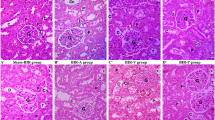Abstract
The technique for assisting renal blood circulation may be a useful therapeutic method in acute cardiorenal syndrome (ACRS), because renal ischemic dysfunction due to the reduced renal blood circulation is a powerful negative prognostic factor in ACRS. We constructed a circuit assisting renal arterial pressure and flow, and performed renal-selective blood perfusion (RSP) to the left kidney in a goat model of ACRS induced by right ventricular rapid pacing (n = 8), with the right kidney left intact as an internal control. Upon induction of ACRS, renal arterial flow (RAF), creatinine clearance (CCr), and renal oxygen consumption (RVO2) of the left kidney decreased to 49, 48, and 63% of the respective baseline values accompanied by a significant increase in renal vascular resistance (RVR), and similar results were observed in the right kidney. Then, RSP improved RVR and increased left RAF, CCr, and RVO2 up to 91, 86, and 93% of baseline values, respectively, without a significant change in systemic hemodynamics. The RSP-treated kidney showed significantly higher CCr and urinary excretion of water and sodium compared to the contralateral kidney. Additional infusion of prostaglandin E1 with RSP decreased RVR further and enabled the left RAF to increase up to 129% of the baseline value, without a significant change in systemic hemodynamic parameters. The CCr and RVO2 did not change significantly, and urinary excretion of water and sodium showed a tendency to increase. These findings suggest that the technique for assisting renal blood circulation for both kidneys may offer a new treatment strategy for patients with ACRS.



Similar content being viewed by others
References
Meyns B, Stolinski J, Leunens V, Verbeken E, Flameng W. Left ventricular support by catheter-mounted axial flow pump reduces infarct size. J Am Coll Cardiol. 2003;41:1087–95.
Reitan O, Steen S, Ohlin H. Hemodynamic effects of a new percutaneous circulatory support device in a left ventricular failure model. ASAIO J. 2003;49:731–6.
Konstam MA, Czerska B, Böhm M, Oren RM, Sadowski J, Khanal S, Abraham WT, Wasler A, Dahm JB, Gavazzi A, Gradinac S, Legrand V, Mohacsi P, Poelzl G, Radovancevic B, Van Bakel AB, Zile MR, Cabuay B, Bartus K, Jansen P. Continuous aortic flow augmentation: a pilot study of hemodynamic and renal responses to a novel percutaneous intervention in decompensated heart failure. Circulation. 2005;112:3107–14.
Ronco C, Haapio M, House AA, Anavekar N, Bellomo R. Cardiorenal syndrome. J Am Coll Cardiol. 2008;52:1527–39.
Rea ME, Dunlap ME. Renal hemodynamics in heart failure: implications for treatment. Curr Opin Nephrol Hypertens. 2008;17:87–92.
Anand IS, Chugh SS. Mechanisms and management of renal dysfunction in heart failure. Curr Opin Cardiol. 1997;12:251–8.
Metra M, Nodari S, Parrinello G, Bordonali T, Bugatti S, Danesi R, Fontanella B, Lombardi C, Milani P, Verzura G, Cotter G, Dittrich H, Massie BM, Dei Cas L. Worsening renal function in patients hospitalised for acute heart failure: clinical implications and prognostic significance. Eur J Heart Fail. 2008;10:188–95.
de Silva R, Nikitin NP, Witte KK, Rigby AS, Goode K, Bhandari S, Clark AL, Cleland JG. Incidence of renal dysfunction over 6 months in patients with chronic heart failure due to left ventricular systolic dysfunction: contributing factors and relationship to prognosis. Eur Heart J. 2006;27:569–81.
Kiil F, Aukland K, Refsum HE. Renal sodium transport and oxygen consumption. Am J Physiol. 1961;201:511–6.
Kurnik BR, Weisberg LS, Kurnik PB. Renal and systemic oxygen consumption in patients with normal and abnormal renal function. J Am Soc Nephrol. 1992;2:1617–26.
Mehta RL, Pascual MT, Soroko S, Chertow GM, PICARD Study Group. Diuretics, mortality, and nonrecovery of renal function in acute renal failure. JAMA. 2002;288:2547–53.
The SOLVD Investigators. Effect of enalapril on survival in patients with reduced left ventricular ejection fractions and congestive heart failure. N Engl J Med. 1991;325:293–302.
Costanzo MR, Guglin ME, Saltzberg MT, Jessup ML, Bart BA, Teerlink JR, Jaski BE, Fang JC, Feller ED, Haas GJ, Anderson AS, Schollmeyer MP, Sobotka PA, UNLOAD Trial Investigators. Ultrafiltration versus intravenous diuretics for patients hospitalized for acute decompensated heart failure. J Am Coll Cardiol. 2007;49:675–83.
Arbid EJ, Hakaim AG, LaMorte WW, Menzoian JO. Prevention of renal cortical ischemia during aortic clamping with prostaglandin E1. Arch Surg. 1995;130:326–30 (discussion 330–1).
Mahmoud IM, Hussein Ael-A, Sarhan ME, Awad AA, El Desoky I. Role of combined l-arginine and prostaglandin E1 in renal ischemia-reperfusion injury. Nephron Physiol. 2007;105:57–65.
Wilkens JH, Wilkens H, Elger B, et al. Cardiac and microcirculatory effects of different doses of prostaglandin E1 in man. Eur J Clin Pharmacol. 1987;33:133–7.
Brecht T, Ayaz M. Circulation parameters during intravenous and intra-arterial administration of increasing doses of prostaglandin E1 in healthy subjects. Klin Wochenschr. 1985;63:1201–4.
Lum GM, Aisenbrey GA, Dunn MJ, Berl T, Schrier RW, McDonald KM. In vivo effect of indomethacin to potentiate the renal medullary cyclic AMP response to vasopressin. J Clin Invest. 1977;59:8–13.
Grantham JJ, Orloff J. Effect of prostaglandin E1 on the permeability response of the isolated collecting tubule to vasopressin, adenosine 3′,5′-monophosphate, and theophylline. J Clin Invest. 1968;47:1154–61.
Author information
Authors and Affiliations
Corresponding author
Rights and permissions
About this article
Cite this article
Hanada, S., Takewa, Y., Mizuno, T. et al. Effect of the technique for assisting renal blood circulation on ischemic kidney in acute cardiorenal syndrome. J Artif Organs 15, 140–145 (2012). https://doi.org/10.1007/s10047-011-0613-5
Received:
Accepted:
Published:
Issue Date:
DOI: https://doi.org/10.1007/s10047-011-0613-5




